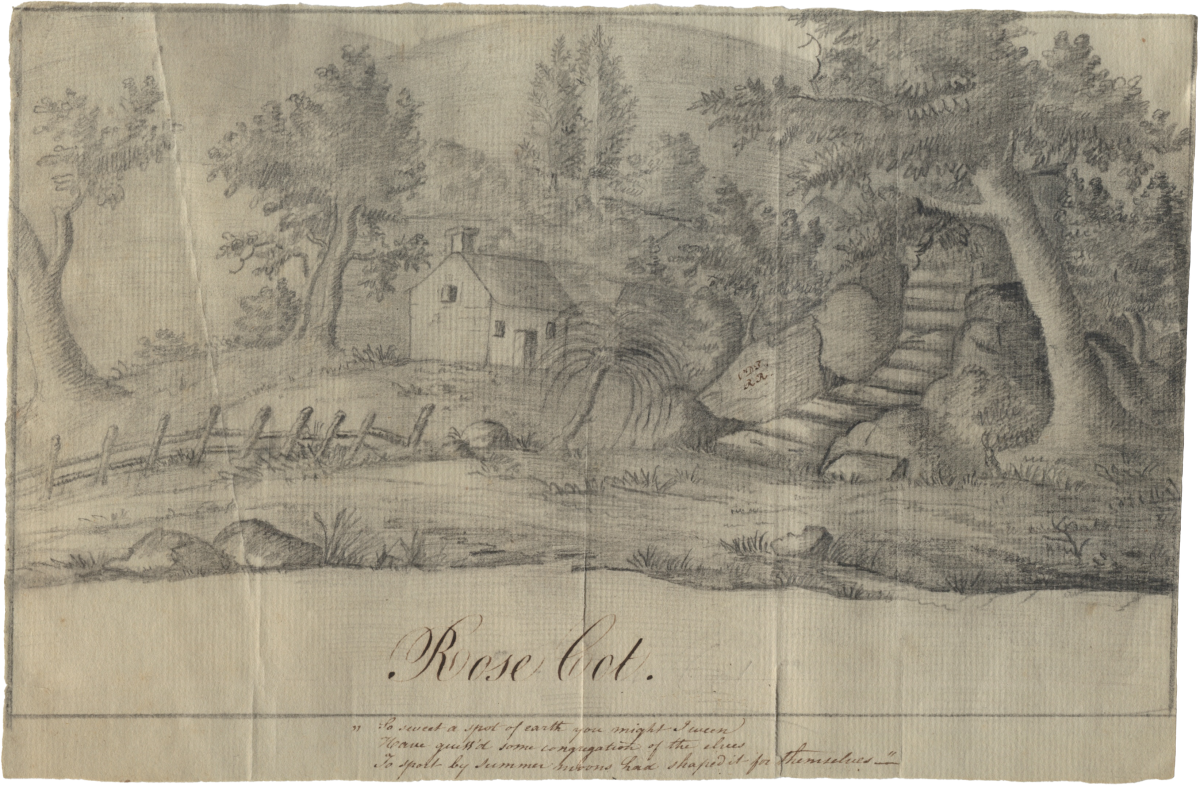While perusing a folder of miscellaneous drawings in the archives at Hagley, I came across an image that I had never seen but recognized immediately (see below). The drawing shows a small cottage situated within a hilly landscape. A rock bearing the initials “VDP” and “RR” sits amongst the foliage, quietly proclaiming the identity of the cottage’s inhabitants. A handwritten note on the back of the drawing confirmed my suspicions, this was Rose Cot, “a favorite resort of Rebecca Ralston & Victorine E DuPont when young girls – somewhere near the country seat of Mr Robert Ralston, which was named Mt Peace.”

For nearly eight years, I have traced Rose Cot through letters exchanged between Rebecca Ralston and Victorine du Pont. I am writing a dissertation that examines how elite, white, southern girls living during the early national and antebellum periods understood the relationship between place and social identity. The correspondence, schoolwork, and other manuscripts written by Victorine, Evelina, Eleuthera, and Sophie du Pont are central to my research. This past fall, I returned to Hagley with the assistance of the Henry Belin du Pont Research Fellowship to further explore the du Pont sisters’ girlhood manuscripts,
Victorine and Rebecca met at a fashionable boarding school in Philadelphia and maintained a regular correspondence for many years. In her letters, Rebecca often expressed her disappointment that she could no longer spend every day in Victorine’s company. When Victorine visited Rebecca at Mount Peace in 1809, the two girls “adopted” an abandoned house that they encountered during an excursion through the surrounding countryside. They called this house “Rose Cot,” “Cot” being an abbreviation for “Cottage.” Their discovery did not remain a secret for long. In a letter written shortly after Victorine’s visit, Rebecca recalled how a recent excursion with her father and two “gentlemen” had brought her within view of Rose Cot:
“Papa recognized it immediately as I had told him in a former ride of our adopted house,” she wrote, “He told the gentlemen who were with us and they laughed at the ‘Romantic girls’ They however admired our taste in choosing the situation They thought it might be repaired and made quite a comfortable little Cot – I protested against having any thing done to it – You know a castle in ruins is more sentimental than one in good repair.”[1]
Following a subsequent visit to the cottage, Rebecca informed Victorine that their “dear little ‘rose cot’…is still uninhabited save by the feathered race some of which have made it a shelter from the storm.”[2] Although she and Victorine cherished Rose Cot, they were not its actual inhabitants. Their status as outsiders was reaffirmed when Rebecca discovered that she could no longer access their favored abode. “Think what must have been my disappointment on going a few days ago to visit Rose Cot to find some ruffian had barbarously shut it up depriving us of the pleasure of sitting there without being serviceable to any body else,” she complained.[3]
Although neither girl ever lived in Rose Cot, it featured prominently in their girlhood memories. During their visits, the two friends could forestall the obligations of womanhood and prolong their girlhood happiness. Here, they could envision themselves as the inhabitants of a space characterized entirely by their imagination and mutual affection. While the land where Rose Cot once stood is now part of Philadelphia, its memory remains carefully preserved at Hagley.
REFERENCES
[1] Rebecca Ralston to Victorine du Pont, October 10, 1809; Winterthur Manuscripts, Hagley Museum and Library.
[2] Rebecca Ralston to Victorine du Pont, May 29, 1810; Winterthur Manuscripts, Hagley Museum and Library.
[3] Rebecca Ralston to Victorine du Pont, June 22, 1810; Winterthur Manuscripts, Hagley Museum and Library.
Emily Wells is pursuing her PhD at the College of William and Mary. She conducted research at Hagley Museum and Library under a Henry Belin du Pont Research Grant.
